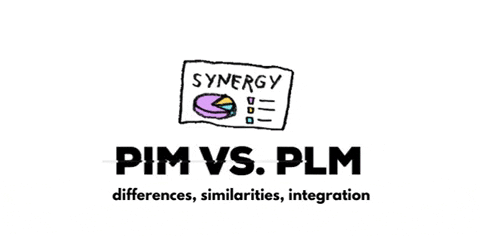
By Ella
3 minute read
Ella By Ella
3 minute read
There are so many abbreviations out there that it gets confusing. What is a PLM? What is a PIM? Is it the same? In this post, we unveil the mystery by defining each system, outlining its differences and similarities, defining the users, and how brands can benefit from their integration. The two combined produce a synergy – a combination that makes brands' digital transformation run smoothly.
What is a PLM?
A PLM software is designed to optimize the entire life cycle of a product from the moment it's conceived, throughout its design, until its manufacturing. It connects product development teams and suppliers and concentrates their communication – which is usually done via email, excel sheets, etc. – all in one platform.
A PLM offers a collaborative solution that relieves a confusing and disorganized process with data spread in different sources by providing a setup that allows brands to organize and structure data. With a PLM, brands work more efficiently during the product development process. This results in productivity boost, reduction of costs, and minimizes mistakes and risks during the sampling process.
READ: A broader definition of what is a PLM and why it is essential for fashion brands?
What is a PIM?
A PIM on the other hand is there to support your multi-channel marketing strategy. As a brand you are selling your products in different online marketplaces. You need to adjust your content to fit the requirements of each channel, whether it is Amazon, Google Shop, Zalando, or Shopify. But you also must boost that content in a way that will help you rank at the top of the page and be attractive to consumers. A PIM stores all your product content for all your sales channels, and gives you the space to make the best optimization, enabling readiness for product launches that increase your time to market.
PIM vs PLM: Similarities
PIM and PLM have a few similarities. They are both software that enable team collaboration and act as a single source of truth and database, where product content and product data respectively are stored all in one place.
However, the users for each one are in different stages of the chain and collaborate for different purposes, and store data in a slightly different manner. While in a PLM the data is rawer, in a PIM this data – that is ideally coming from a PLM – it is being optimized to make attractive and colorful content for SEO, marketing campaigns, e.commerce, etc.
PIM vs PLM: Who are the users?
PLM users are product developers, designers, technicians, buyers, purchasing managers, suppliers, CEOs, but it always depends on how the brands set up their creative teams.
While PIM's primary users are the marketing and sales departments.
In the ideal world, as a brand, you would have both software connected and integrated. The PLM provides all product data structured to the PIM, where you can enhanced to fit the different requirements of e-commerce platforms and other sales channels.
Having all product data gathered in a PLM facilitates the transfer of this information to a PIM. The PIM imports it and start improving it, instead of receiving it in different files with inaccurate or little information, which ultimately affects the communication in marketing and sales.
PIM and PLM integration benefits
Imagine a scenario where your product is ready to be sold, but the content is not ready because the data is still being collected from all the different sources? That’s where both PLM and PIM can work together.
Product data is created in the PLM as part of the product development process when designers and manufacturers develop new products. The PLM structures and centralizes the product data which later marketing and sales can automatically import into the PIM.
Key benefits of the integration
- Automatic import of SKUs into PIM
- Centralized product data management
- Import designers’ product descriptions directly into PIM
- Time saving on double data entries
- Less product data mistakes
- Faster time to market
READ MORE: PLM Benefits for Marketing and E-commerce